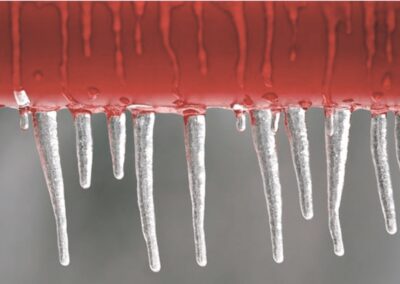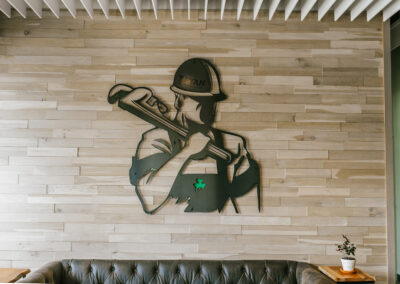When is the worst time to know that a fire sprinkler system, fire extinguisher or fire alarm system would not pass inspection? How about after a visit from the local fire marshal or maybe after a devastating fire? This is why regular fire sprinkler inspections and testing are mandated by code. The inspection and testing provide some assurance that a fire sprinkler system will perform when it is needed most.
Visual inspections are part of the inspection, testing, and maintenance required by the National Fire Protection Association (NFPA). NFPA defines an inspection as “a visual examination of a system or portion thereof to verify that it appears to be in operating condition and is free of physical damage.”
Below is a list of the necessary NFPA required inspections as well as their required frequency. Some of the inspections should be completed by a certified fire protection company and some items can be completed in-house. For example, doing a weekly visual inspection of a gauge isn’t so difficult, and a Ryan Fireprotection expert can help point out what needs to be done. However, for annual, semi‑annual, or quarterly inspection requirements, Ryan Fireprotection provides experienced and trained staff who know exactly what to look for when performing the inspections:
Daily / Weekly Visual Inspections
Sprinklers NFPA 25
- Valves, Valve Components, Trim Inspections (Sealed Control Valves, Master Pressure Reducing)
- Backflow Prevention Assemblies (Reduced Pressure, Control Valves [Locked/Supervised])
- Gauges (Dry, Preaction & Deluge Systems)
- Standpipe (Sealed Control Valves, Gauges [Automatic Dry Standpipes])
- Fire Pump System (Casing Relief Valves, Pressure Relief Valves, Pump House, Heating Ventilating Louvers)
Automatic Fire Alarm NFPA 72
- Control Equipment: Fire Alarm Systems Unmonitored for Alarm, Supervisory and Trouble Signals (Fuses, Interfaced Equipment, Lamps/LEDs, Primary Power Supply)
Monthly Visual Inspections
Sprinklers NFPA 25
- Control Valves, Alarm Valves [exterior bells], Dry Pipe, Deluge, Preaction Valves)
- Gauges (wet, dry, preaction, and deluge systems) • Valves, Valve Components, Trim Inspections (Locked/Supervised
- Standpipe (Control Valves [Locked/Supervised], Gauges [Automatic Dry Standpipes with Air Pressure Supervision])
- Private Fire Service Mains (Hose Houses)
- Backflow Prevention Assemblies (Double Check Valves, Control Valves [Locked/Supervised])
Portable Fire Extinguishers NFPA 10
- No obstruction to access or visibility
- Location Pressure Tamper Indicator, Hose/Nozzle Sign, Hanger, Hazard Extinguishers Assessment, HMIS Label
- Examination for obvious physical damage, corrosion, leakage or clogged nozzle
- Location in designated place
- Safety seals and tamper indicators not broken or missing
- Fullness determined by weighing or “hefting”
- Operating instructions on nameplate legible and facing outward
- Pressure gauge reading or indicator in the operable range or position
- HMIS Label in place
- Condition of tires, wheels, carriage, hose, and nozzle checked (for wheeled units)
Automatic Fire Alarm NFPA 72
- Batteries: Lead-Acid, Nickel-Cadmium, Primary Dry Cell, Sealed Lead-Acid
Quarterly Visual Inspections
Sprinklers NFPA 25
- Valve Supervisory Switches
- Pressure Reducing and Relief Valves
- Waterflow Alarm and Signal Devices
- Gauges (Wet Pipe Systems)
- Fire Department Connections
- Hydraulic Design Information Sign
Semi-Annual Visual Inspections
Sprinklers NFPA 25
- Private Fire Service Mains (Monitor Nozzles)
Automatic Fire Alarm NFPA 72
- All Initiating Devices (Smokes, Heats, Ducts, Releasing Devices, Carbon Monoxide, etc.)
- Remote Annunciators
- Batteries: Lead-Acid, Nickel-Cadmium, Primary Dry Cell, Sealed Lead-Acid
- Supervising Station Transmitters (Dact, Dart, McCulloh, Rat)
- Transient Suppressors (Lightning Protectors)
- In-Building Fire Emergency Voice/Alarm Communications Equipment
- Alarm Notification Devices (Horns, Strobes, Speakers, Chimes, Bells, Etc.)
- Mass Notification Systems, Non-Supervised Control Equipment
Annual Visual Inspections
Sprinklers NFPA 25
- Valves, Valve Components, Trim Inspections (Interior Dry, Deluge, Pre-action, Pressure Reducing Valves)
- Spare Sprinklers
- Pipe and Fittings (from floor)
- Hangers/Seismic Bracing (from floor)
- Sprinklers (from floor)
- Hydraulic Design Information Sign
- Information Sign
- Standpipe (Piping, Hose Racks, Hose Connections/Hose Valves, Hose/Hose Nozzles)
- Private Fire Service Mains (Hydrants, Main Line Strainers)
Portable Fire Extinguishers NFPA 10
- Hanger/seismic bracing
- All of monthly inspection, plus conductivity test (Carbon Dioxide)
- Determination of 6 year or Hydrotest, Inspection of shell and nameplate
E-Lights/Exit Signs NFPA 101, 70
- 90 Minute drain test and inspection, verification of charge voltage, alignment of heads, hazard assessment, inspection sticker, required paperwork
5-Year Visual Inspections
Sprinklers NFPA 25
- Internal Pipe Inspection/Assessment
- Valves, Valve components, Trim Inspections (Strainers, Filters, Orifices, Interior Check Valves, Interior Alarm)
Whenever our team of experts is out for inspections and testing, the facility manager will receive a complete report of the condition of each item and a detailed comment for each issue that is found. This report will also serve as part of a building owner’s or facility manager’s record-keeping commitment.
Contact Ryan Fireprotection to discuss these services. A representative will design a custom schedule to meet the code requirements, the requirements of the local authority having jurisdiction (AHJ), and each facilities’ particular needs. For instance, if a building or facility does not have the available staff, Ryan Fireprotection will perform the inspections that are required on a weekly or monthly basis to ensure that the building is in compliance with all the requirements.

